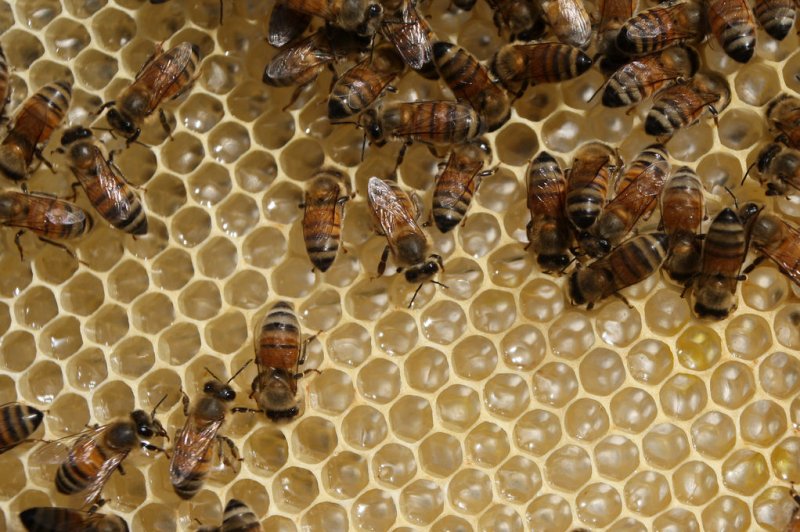Honey bee colonies experienced unusually high losses in the U.S. during the summer of 2019. Photo by Ismael Mohamad/UPI |
License Photo
June 22 (UPI) -- Beekeepers in the United States lost 43.9 percent of honey bee colonies between April 2019 and April 2020, but surprisingly, a majority of the losses were recorded during summer months.
Every April, researchers with the Bee Informed Partnership distribute flyers to beekeepers across the United States. Participants are asked to provide information about the colonies they managed over the past 12 months.
The results of the latest survey were released online Monday, showing summer was much worse than winter last year.
"They give us the number of colonies they managed at different times, the number of splits they made or new colonies they bought, or sold, etc., and from all that information, we calculate the 'turnover rate,'" Nathalie Steinhauer, BIP's science coordinator, told UPI in an email.
Researchers expect to see fluctuations in the turnover rate from year to year, usually with particularly bad years followed by less dramatic losses, and vice versa. But typically, winters are worse than summers -- especially for small-scale beekeepers.
According to the latest results, losses over this past winter were down 15.5 percentage points from the winter before.
"We recorded high losses in the summer of 2019 on the other hand," said Steinhauer, who is also a post-doctoral researcher in the entomology department at the University of Maryland. "And when we dig deeper into beekeeper categories, we realized it was mostly large sale migratory beekeepers that seemed to suffer the most that summer."
The Bee Informed Partnership's survey results don't offer a colony-by-colony autopsy report, but the questionnaires distributed to beekeepers do inquire about the suspected cause of colony losses.
"We ask beekeepers their opinion as to what caused their colonies to be lost, but it is rather subjective, and mostly indicative of what the beekeepers perceive are the high risks factors," Steinhauer said.
While understanding how beekeepers perceive risk can be useful, Steinhauer said there's plenty of research highlighting the biggest threats to honey bee colony health.
The biggest threats to bee colony health include: parasites, particularly the Varroa mite; a variety of viral, bacterial and fungal pathogens; pesticides; and poor nutrition. All of these threats can be exacerbated by weather patterns and poor management practices, experts say.
According to Steinhauer, weather anomalies best explain the unexpected results from the latest survey.
"We have heard anecdotally from various sources that spring 2019 was particularly late and wet, slowing a lot of the development of colonies and queen rearing early in the year, which meant colonies did not grow as strongly as you would have wanted," she said.
Despite alarmist stories about bee losses, honey bees aren't on the verge of extinction. Bee keepers are usually able to replenish their colony stocks via hive splitting and other management techniques to replace annual colony losses. Still, there is plenty of evidence that both wild and managed bees are facing a litany of environmental threats.
"Some level of colony turnover is normal, but the question is how much is normal and how much is too much," Steinhauer said.
The Bee Informed Partnership was largely started to help answer that question, but Steinhauer suggests there's still not yet enough data to say for sure.
"We know from beekeepers that they think the current levels are really high," she said. "Also, a lot of beekeepers tell us that they've managed to keep the colony numbers high, but they notice the colonies are not as 'plump' as they used to be. It's hard because again, we don't have historical data on those aspects either. So, generally, we say our goal is to improve honey bee health."
In addition to continuing to collect data on colony losses, Steinhauer and other honey bee researchers are working on ways to combat the honey bee's biggest threats, including pests, pathogens, pesticides and poor nutrition.
"Each of those can affect honey bees directly, and each of those impact the effects of the others," Steinhauer said. "Nutrient deprived bees have lower capabilities to detoxify pesticides; infected bees will not collect as much food from their environment. It is all a vicious circle where one stressor makes it harder for bees to resist the others."
Research suggests that when bees have access to a greater diversity of plants and live in generally healthier ecosystems, they're better able to fight off parasites and resist disease.
"There is no single culprit which means there is no single solution. But if we generally improve the environment our bees -- and we -- live in, it might help more than the bees themselves," Steinhauer said.















